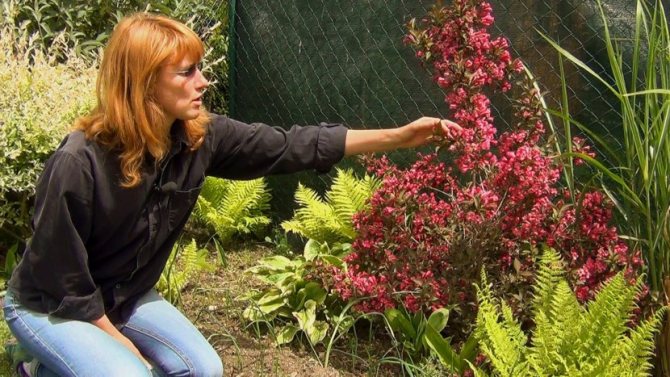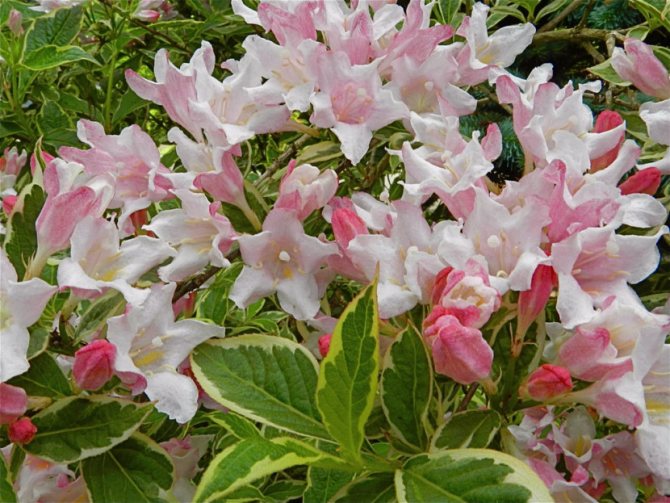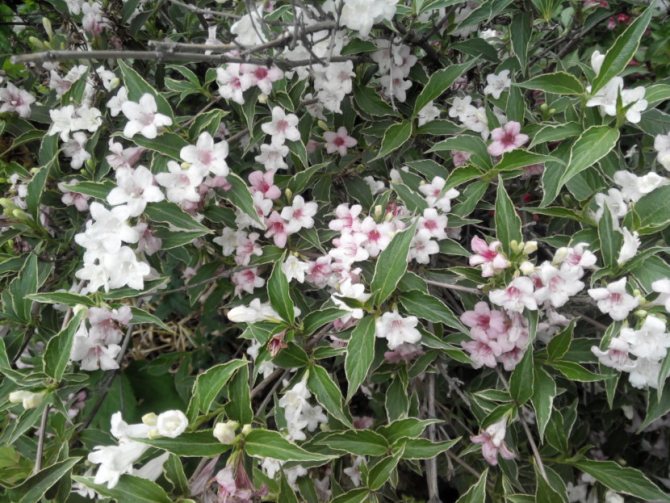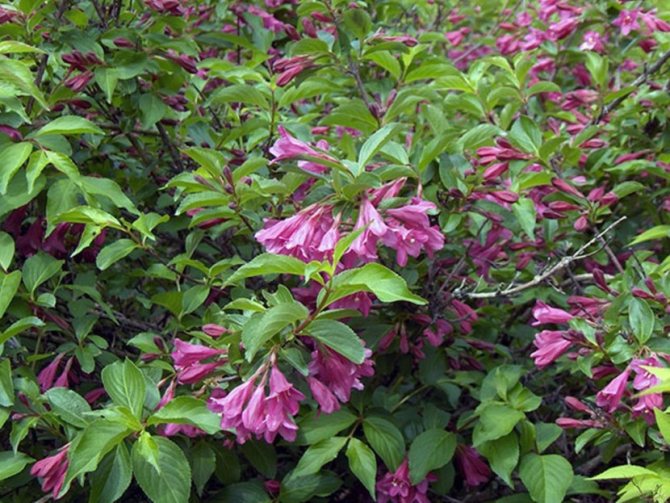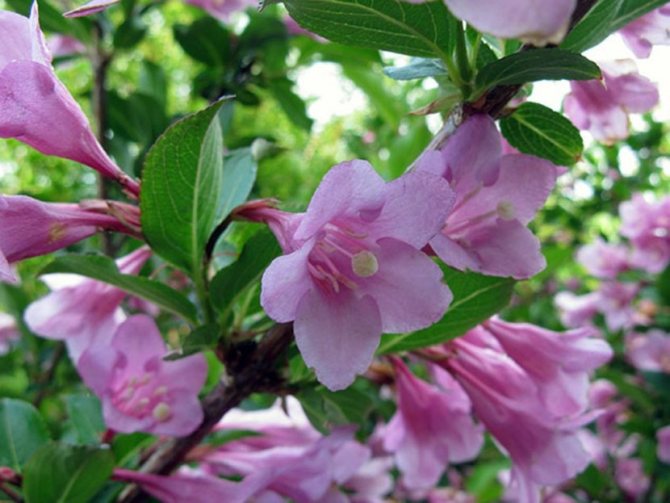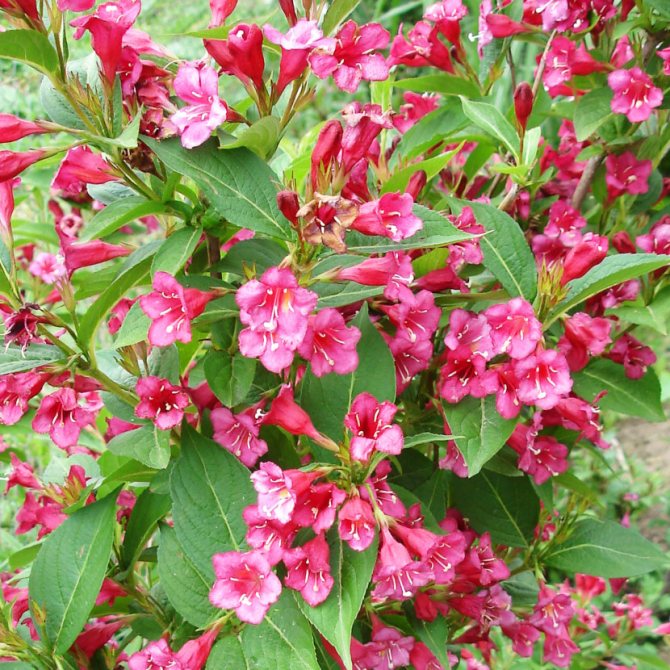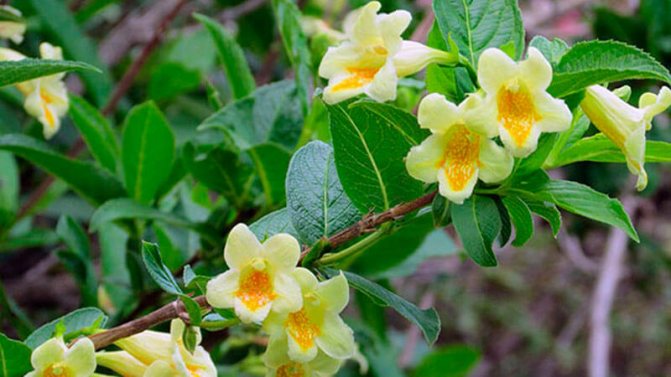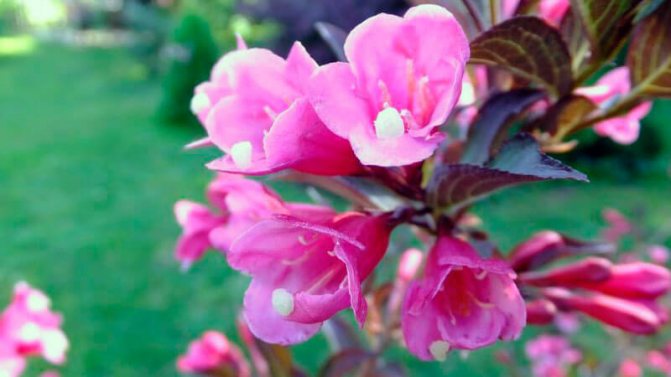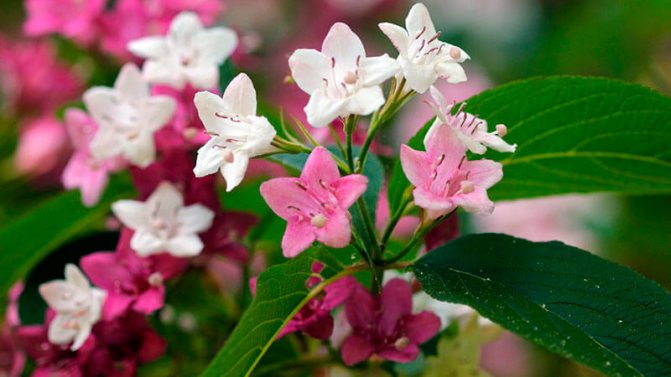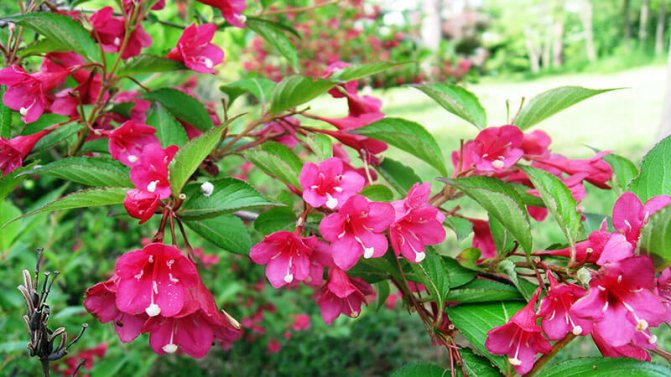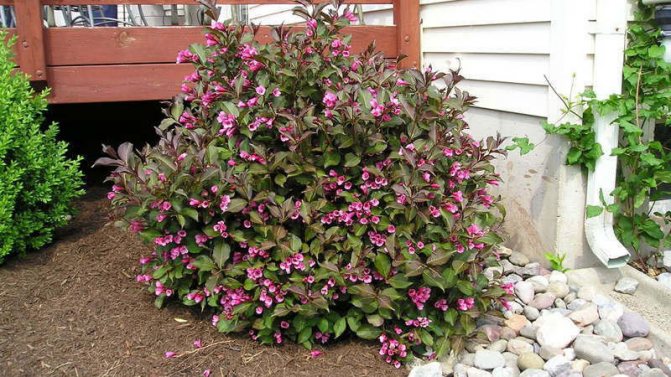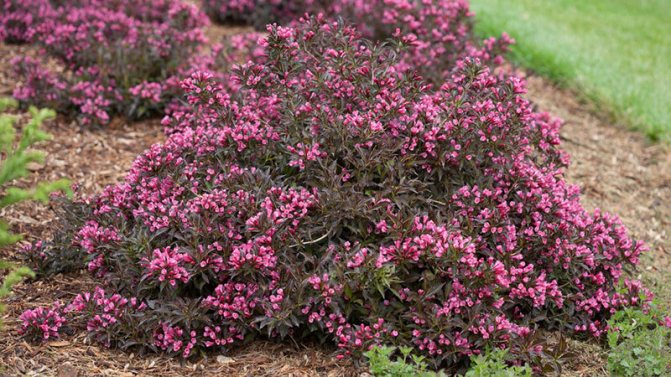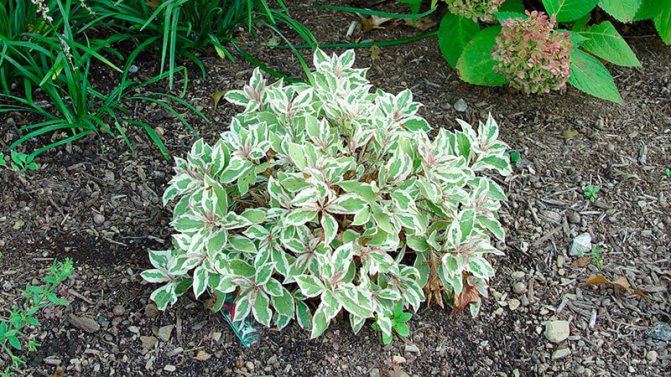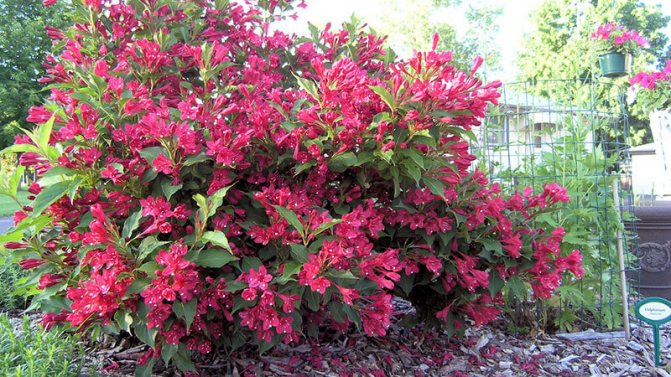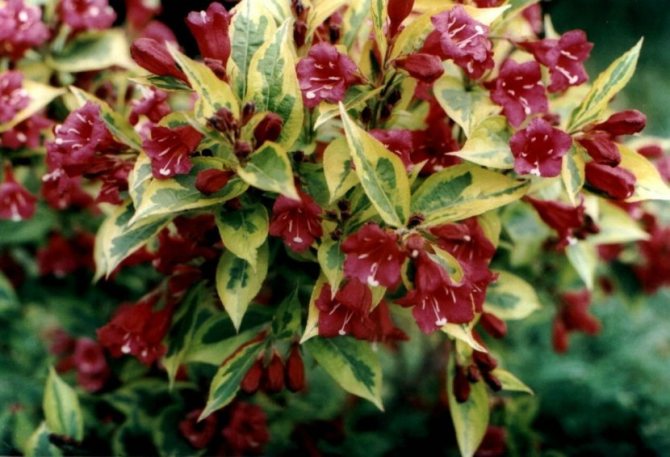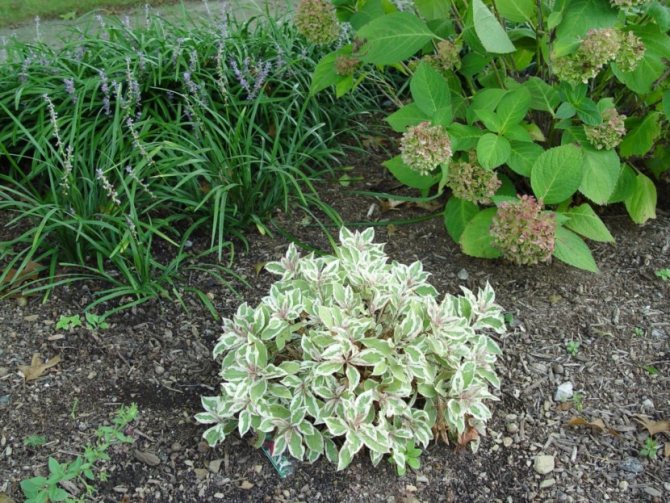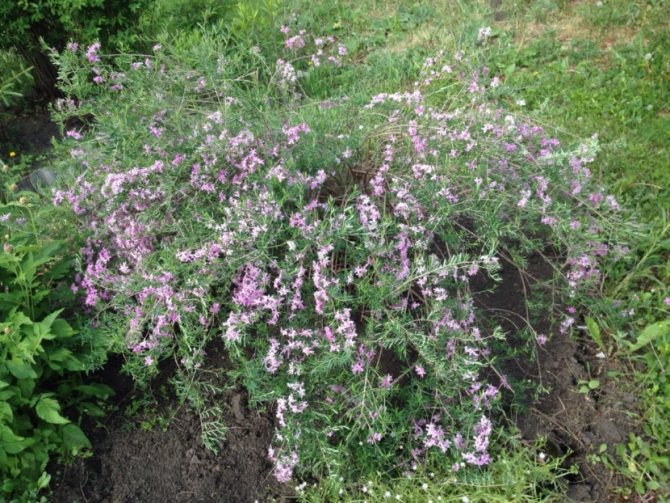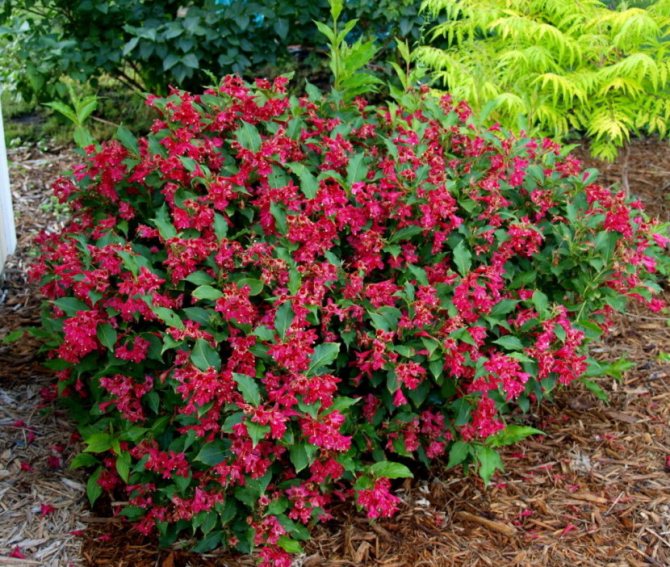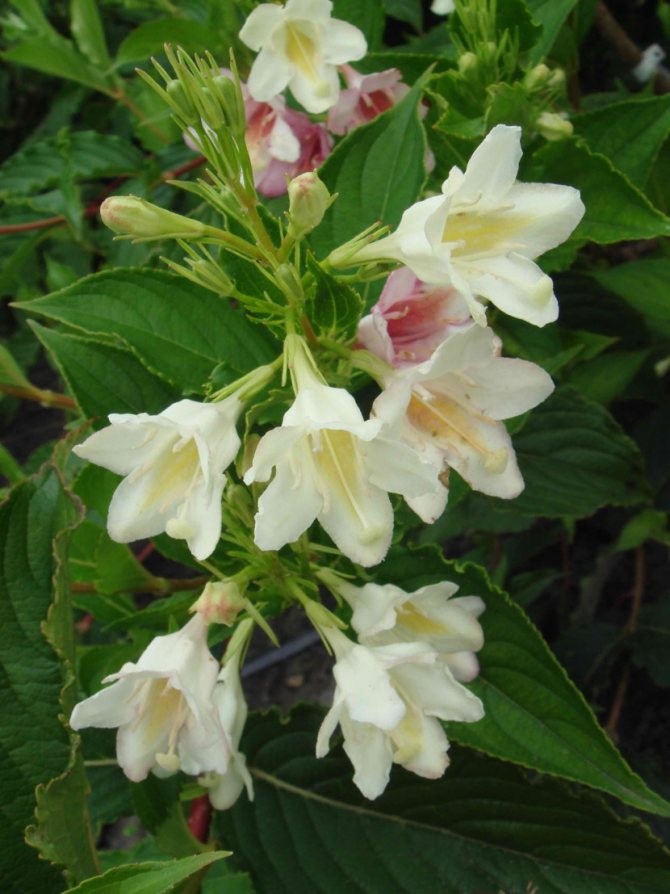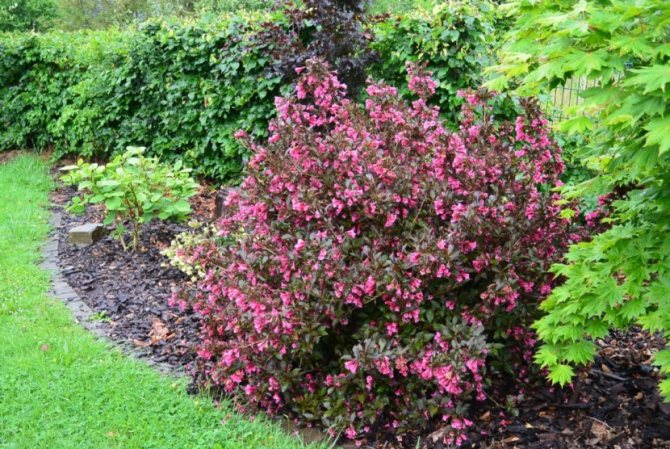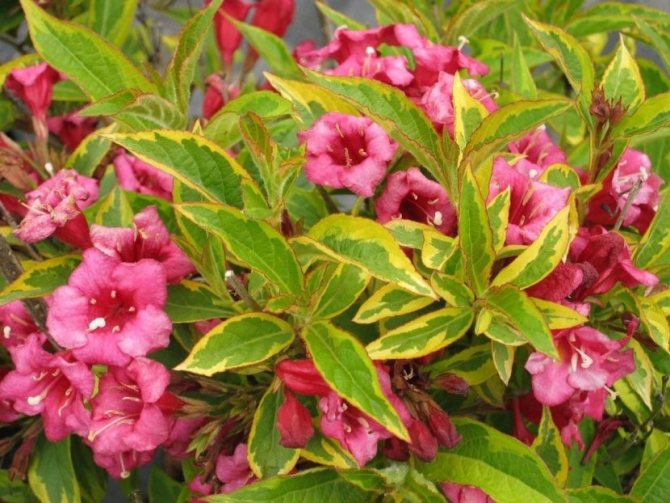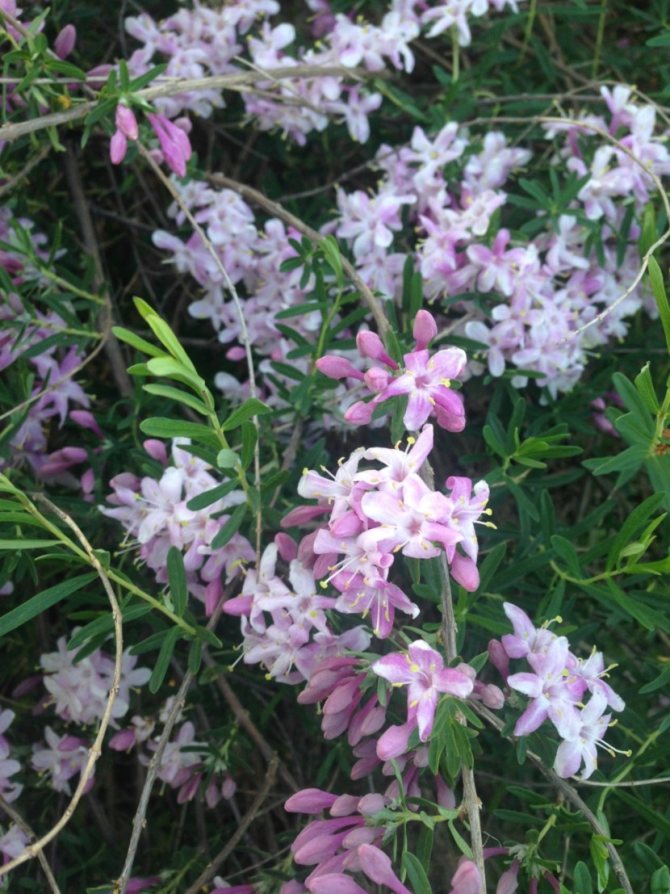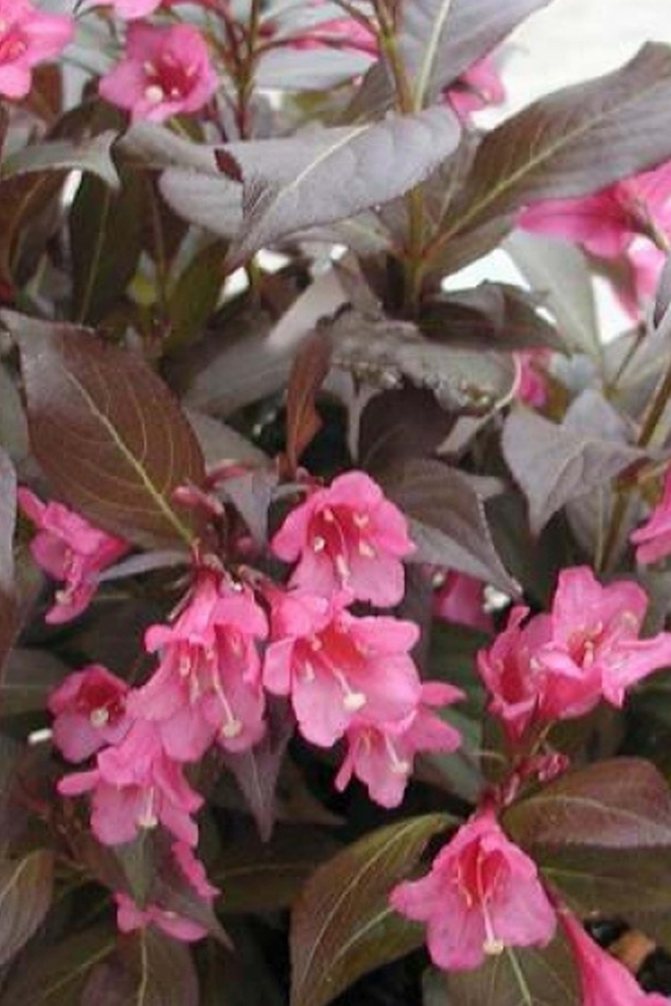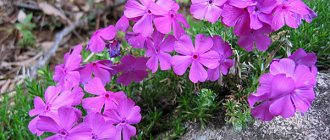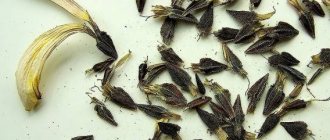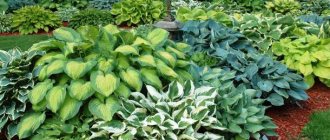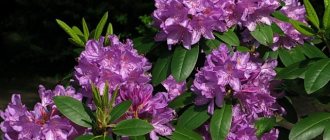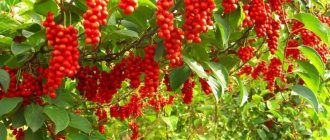Many gardeners in Russia prefer to plant deciduous ornamental shrubs in their summer cottages, bringing a zest to the entire appearance - this is weigela... Planting and caring for the presented shrub does not require special physical costs and time.
However, like any plant, this decorative beauty should also be looked after according to the rules, which should be carefully considered and determined for yourself, and whether you can cope with the task at hand.
Everyone is envy! The most beautiful varieties of weigela
Most often, on our homestead plots, you can find hybrid varieties of weigels with a beautiful spreading crown, they bloom delightfully, and there are weigels that are valued for their originality of color.
There are varieties with such abundant flowering, from which it is impossible to take your eyes off. For example, the variety «Bristol Ruby» - branched shrub up to 2.5 m in height.
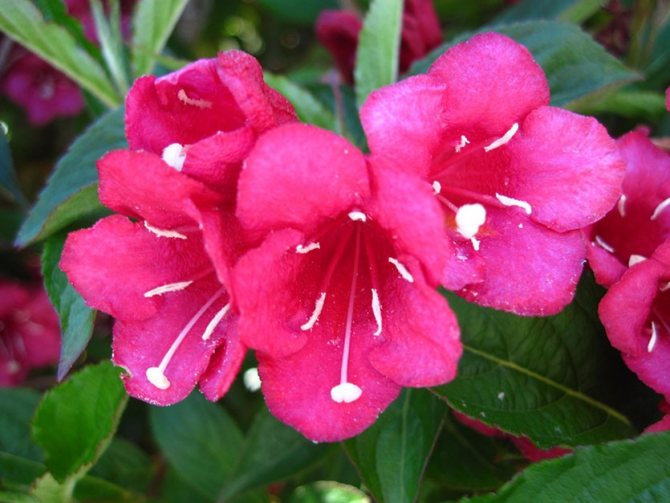
Its flowers are ruby red with a purple center. Blooms in May-June. A fast-growing variety, and after two to three years it reaches its maximum size. This plant can be recommended for those looking for beautiful, unpretentious and fast growing perennial shrubs.
Variety «Brigela"(FRENCH LACE) also grows rapidly up to 2.5 m. The leaves have a yellow edge, and against their background there are very beautiful flowers of dark pink color. Flowering occurs in June-July. This variety is especially good for contrasting color compositions.
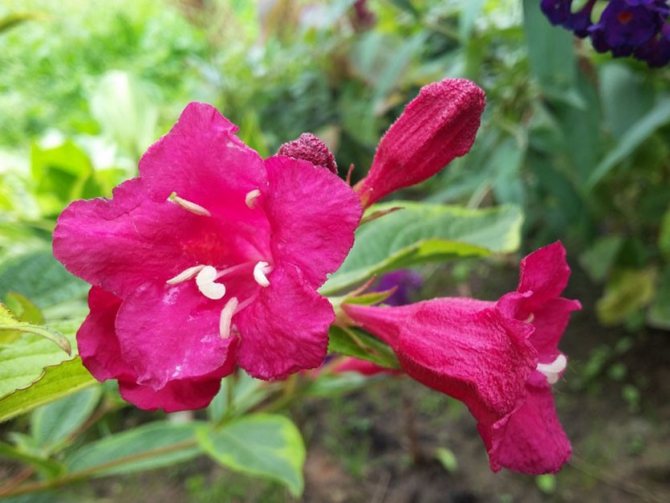

Of the varieties with spectacular dark red flowers, the variety will be even more interesting «Olympiade» (BRIANT RUBIDOR). He has rather large greenish-yellow leaves, saturated red flowers up to 3 cm in diameter. This variety looks very impressive. You also need to pay attention to the most beautiful varieties with bright flowers. «Rumba» (dark pink), «Red Prince» (bright red), and «Courtared» (LUCIFER, purplish red).


Varieties with white flowers - this is the very tenderness and grace. And you can't see from afar what kind of white cloud of inflorescences it is. Variety «Bristol Snowflake» will open its greenish-yellow buds into large, up to 3 cm in diameter, snow-white, shiny flowers. It blooms very profusely. Add in the height and width of up to 1.8 m and imagine what a magnificent sight it is. Variety «Candida» will grow slightly taller, up to 2.5 meters, and up to 3 m wide. The flowers are large, about 3.5 cm in diameter, white with a yellow spot in the middle.
Weigela dwarf varieties... Maximum grade height «Verweig 3» (MINOR BLACK) does not exceed 75 cm, and it is no more than 1 meter wide. On the reddish-brown shoots, there are small and shiny leaves of the same color. Add to them dark pink flowers up to 2.5 cm in diameter, which are very medium-sized, but appear in numerous inflorescences in June-July, and you get a very effective, compact and beautiful plant. It will look beautiful in combination with the same shades of tanning skumpia, vesicle, hybrid or small-flowered heuchera. It will also look interesting against the contrasting background of low conifers.
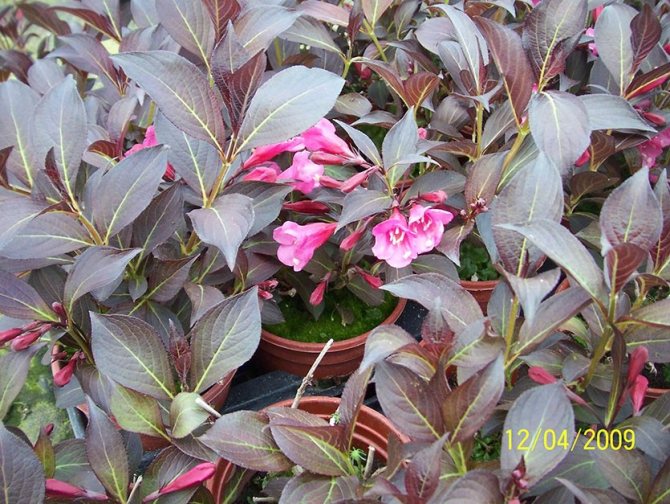

Variety «Verweig» (MONET) is one of the lowest varieties of weigela, and its height will not exceed 50 cm. The leaves of this variety are unique and highly decorative - from red-pink to green, in summer a white-pink border appears, which darkens in autumn.The flowers are light pink. It is used for single plantings, or for contrasting compositions that emphasize the uniqueness and beauty of the foliage. Varieties «Victoria» and «Nana Purpurea» in height will also be no more than a meter. The leaves of both varieties are dark red, pink flowers will appear in June-July. Variety "Eva Rathke" differs in a compact form of a bush, the height of which does not exceed 1 meter, but it grows up to 2 meters wide. Its brilliant blood-red flowers appear in June-July.


Weigela varieties with unusual, variegated leaves... Variety «Caricature» will surprise you with its crooked and crumpled leaves with a yellow border. Its height is up to 1.8 m, and its width is about 2 m. Its flowers are light pink, inconspicuous and not abundant. It is valued for its unusual foliage and looks perfect against the background of darker colored plants. The color of the leaves of the variety is interesting «Verweig 2"(CAPPUCCINO). In young foliage, it is yellow-green with purple-brown erosion, and in older foliage it is olive or light brown. Their shape is oval. The flowers are pink with a reddish calyx. The variety «Variegata» variegated gray-green leaves with a yellow-white border. The shrub of this variety is wide and spreading, up to 2.5 meters in height. White-pink, "marshmallow" flowers appear in May-June.


Weigela varieties «Looymansii Aurea» non-standard vertical crown of a bush up to 1.5 m tall with beautiful golden leaves. The flowers are pink, not large. A very original plant.
Weigel Middendorf Is a separate song in your garden. Once you see all the beauty of this plant, you will love it forever. The canary-colored flowers gleam amazingly in the sun. Inside the corolla there may be orange or red spots, and the flower itself is an elongated cylindrical tube-gramophone up to 4 cm in diameter. Blooms in May-June. It is the most frost-hardy species of weigela and can grow in light partial shade.
All weigels are excellent both as tapeworms and in groups with other plants. There are no people indifferent to this plant. Acquire, grow and propagate weigela "beautiful". Decorate your garden.
The advantage of variegated weigela in design
Without a doubt, the variegated species of weigel in landscape design is universal. This is a wonderful opportunity to play with color, giving the corner of the garden where a bush or a group of bushes will grow, zoning or decorating the site, lightness and liveliness with the peculiarity of the color of the leaves: the green of the leaf plate is bordered by a white, yellow or silver rim. Grayish - green leaves with shades of red or brown look unusual.
The variegation of the plant will ensure the absence of monotony of greenery outside the flowering period. And twice a season, weigela will decorate the site with various shades of pink bloom.
The choice in using this miracle species is yours: to form a hedge, a standard form, to leave an unformed natural bush. In any version, variegated weigela will be an excellent decoration for the garden landscape.


Weigela variegated
Overview of varieties and species of Weigela
Weigela is an exquisite garden plant that can beautify any garden with just one look. The shrub is incredibly beautiful during the flowering period, when bright brushes of inflorescences descend along its hanging branches. Thuja care instructions are here: https://enn.imadeself.com/rasteniya/kustarniki/rekomendacii-po-posadke-i-uxodu-za-tuej.html.


Weigela blooming in the garden
Description and characteristics of weigela
German professor of botany and chemistry K.E. von Weigel was the first to discover this type of flowers, after which it was named. The whole genus of these flowers is presented in 15 species, and you can find various varieties of weigel in Far and East Asia. This is a perennial lush shrub of a deciduous type that has the ability to bloom again, and it is especially valued for the beauty of its inflorescences, a tubular-bell-shaped type, but sometimes weigel also has single flowers. The leaves of the shrub are also very beautiful - with a white edging of green. weigela winter hardiness.
Weigela is a lover of warm climates and mild heat. But the cold winter is not well tolerated by these flowers. Only some winter-hardy varieties are able to survive the winter.But if the frost nevertheless damaged the plant, it can recover in the same year and even please with flowering. In winter, it is better to cover shrubs in severe frosts. Read in detail how to plant thuja western Danica and how much the seeds cost.
The height of weigel shrubs depends on the type of plant, but most often the bush has a height of 1.5 m, only some species reach 3 m in height.
Types and varieties of weigela
The homeland of this weigela is North China, also Japan. The plant reaches a height of 3 m, prefers light partial shade. Then its motley leaves turn green. Flowering begins in May and lasts until the end of June. On the side shoots, abundant boxes of inflorescences up to 5 cm appear in size, pale or bright pink in color. This weigel variety loves slightly acidic, moderately moist soil and does not tolerate stagnant water. Therefore, with careful watering, good lighting and not a strong large density of planting of Weigela shrubs, the flowering reaches the maximum beauty of flowering lasting 20 days.
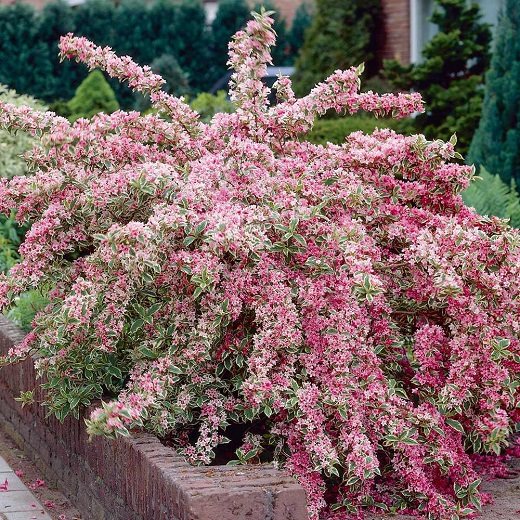

Weigela variegata or weigela nana variegata
A variety of shrubs from the genus Honeysuckle. It takes root well in the Western European climate. Plants reach 70-90 cm in height. They do not like windy places, but they tolerate winter well. Also, this variety is distinguished by its resistance to substrate compaction. The bells are 3-4 cm in size and have a bright pink color. This weigela withstands poorly lit areas, slightly alkaline and acidic soils. But in the spring you need to cut off the shoots so that new ones with bright green leaves grow. The main thing is not to do this during the flowering period - from mid-May to the first half of June. These shrubs look great in landscape compositions and as a single plant. Some create a flowering hedge out of these bushes.
Weigela: planting and care in the open field
Self-cultivation of weigela requires compliance with the basic rules that can help to achieve the maximum beauty of the shrub in the shortest possible time. All plant care is concluded in three stages: planting, growing, shelter for the winter to preserve.
Each of the stages contains its own characteristics, in which novice gardeners make mistakes. Of course, they do not lead to sad consequences, but the very fact of the absence of flowering, which follows most often in such situations, is significantly depressing and saddening.
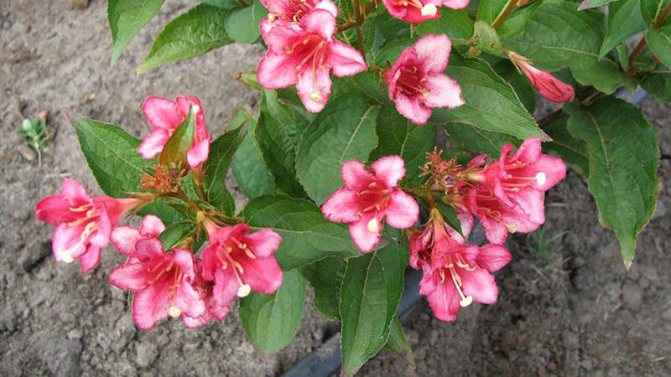

General information on bush care
Before delving into the details of caring for a plant, you should consider its main parameters. TO basic rules for caring for a weigela of any kind include:
- shrubs require good lighting, only some varieties are ready to grow in partial shade;
- an excess of moisture is dangerous for a plant;
- the soil must have medium acidity for further productive flowering;
- weigela should be regularly fed in compliance with the characteristics and parameters depending on the variety.
Even a novice gardener can observe the listed aspects. Making mistakes from the listed aspects can lead to the death of the plant, if resuscitation measures are not taken.
About caring for weigela, video:
Weigela ornamental shrub: species and varieties
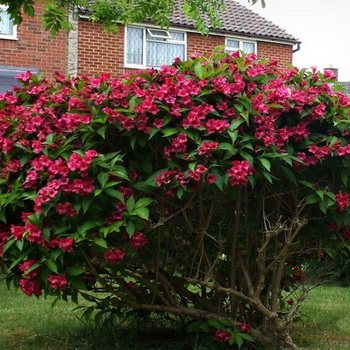

Weigela ornamental shrub from the hydrangea family is a frequent visitor to backyard gardens. Its branches, densely covered with pink (less often white) flowers, retain their decorative effect even after flowering. Due to its ease of care, the weigela garden shrub has gained wide popularity. The main thing is not to forget to prune the plant from time to time in order to maintain a compact shape.
Pruning is carried out once every 2-3 years, removing old shoots. The best pruning time is right after flowering ends. Young shoots can be shortened 1/2 of their length. This pruning promotes growth in the thickness of the main shoots and makes them more resilient.
For the winter, after leaf fall, the bushes are tied and bent to the ground. In winters with little snow, the varieties are covered with spruce branches, lutrasil.
Next, you can familiarize yourself with the photo and description of the weigela shrub of various species and varieties.
Proper care for weigela
Immediately after disembarking, the weigela requires careful maintenance., which consists in regular watering as the soil becomes dry and loosening to the depth of the bayonet of a standard shovel. Every time before loosening, the material used for mulching is removed and then a new one is laid.
In the first 4-5 years of shrub growth after planting, such care must be carried out twice per season. In the future, such procedures will be reduced to a minimum.
Proper care of the presented ornamental shrub implies regular feeding. In the first two years after planting, there is no need to carry out such procedures. There is enough of the complementary food that was carried out even before disembarkation.


In subsequent years, the bush is fed in accordance with the following scheme:
- In early spring, it is necessary to equip the soil with nitrogen-containing fertilizers.
- During the period of bud formation, potassium sulfate is used, which promotes lush flowering.
- The last feeding is carried out after flowering or before wintering in September-October. Any potash fertilizers are also used here.
Sometimes weigela needs to be transplanted. This may be required during the period of abundant growth of shoots or in order to change the place of cultivation. It is better to replant the shrub in the spring, since the roots of this plant are especially vulnerable and any change in dislocation can harm the plant.
Weigela transplant in autumn may end sadly. The roots will not only not take root over the winter, but will also die.
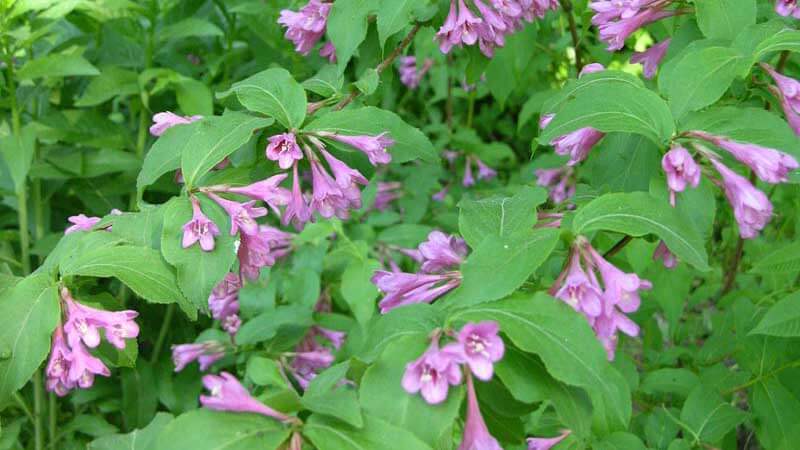

Correct pruning of weigela
Weigela should be trimmed in the spring. During this time, damaged, dead or frozen branches can be removed in order to root the growth of young shoots. To do this, remove old shoots and cut off new ones, leaving the two lower ones.
Pruning the weigela in the fall is not recommended., since in most cases new shoots remain to grow, which may not survive the cold winter.
If you leave the shrub in its original form for the whole winter, then the strengthened branches will perfectly protect new shoots, which will lead to their further fastening in spring and summer.
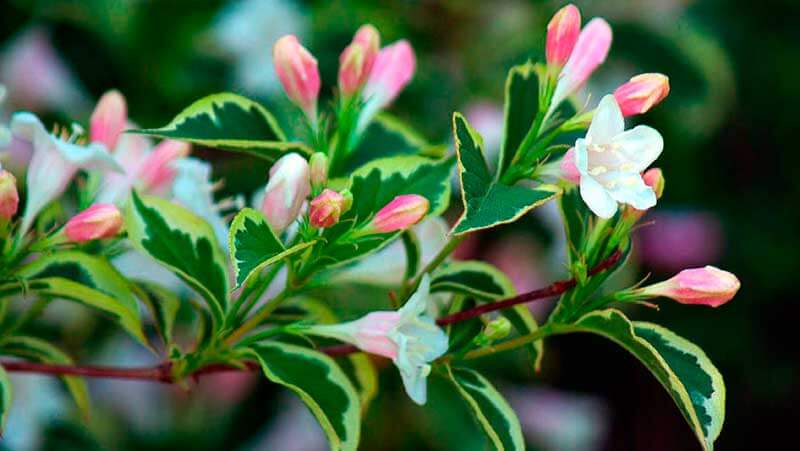

If pruning was required in the fall, then the basic rules should be followed. It should also be noted that the purpose of the presented process is to prepare the shrub for winter. A certain insulation technique may require the correct shape of the bush, which is what gardeners do by removing branches and shoots. How to prune a weigela in the fall:
Pay attention to this material - Ornamental shrubs for cottages and gardens.
Prune the shrub to form a crown by cutting it to the required length using a slanting pruner. Make sure buds remain on the shoot.
- Before wintering, you can remove very old and dry branches. This is done practically at the roots themselves, leaving no more than 10-15 cm of the shoot.
- Keep an eye on your shrub and do not allow free growth, as this can provoke any problems in the normal growth of the weigela.
Shrub pruning, video:
How weigela grows
Characteristics of the environment necessary for the successful growth of the weigela:
- calm place;
- fertile soil;
- the shrub develops ideally in the sun or in light partial shade;
- waterlogging is undesirable.
When these rules are followed, the plant achieves optimal growth, demonstrating decorative qualities.
Some of the weigel give wide crowns, so it is permissible to carry out a slight pruning of the shoots in order to give the plant the desired shape. Some varieties grow slowly - no more than 10 cm per year, others give abundant, rapid growth, due to which the plant matures in a short time.
Pests and diseases
With good care, weigela rarely gets sick, but insect pests can be dangerous. Most often it is infested with aphids, caterpillars, thrips and spider mites. Extreme heat and low humidity increase the risk of infestations by these insects. To combat them, toxic drugs are used, for example, Keltan, Nitrafen or Rogor. To completely get rid of insects, it is enough to twice treat infected bushes with one of these insecticides. More environmentally friendly means are water infusions of wormwood, hot pepper, garlic or potato tops.
Attention! You can protect the planting of weigels from the invasion of aphids by planting marigolds or delphiniums nearby.
Sometimes the roots of the bush infect the larvae of the beetle or bear. Their presence can be suspected by the yellowing and wilting of the leaves soon after planting the seedling. Solutions of Aktara or Karbofos will help get rid of these pests.
If the plantings of weigela have suffered from bacterial or fungal diseases, such as gray rot, rust or spotting, they should be treated with Bordeaux liquid.
For prophylaxis, during the opening of the leaves, the shrub should be sprayed with a 3% Topsin solution.
Varieties of weigela
There are eight common, non-hybrid, varieties of weigela:
- Weigela middendorffiana - blooms in spring and autumn with yellow flowers with orange spots. Shrub height - up to 1.5 m, planted singly, on lawns, under trees with sparse crowns.
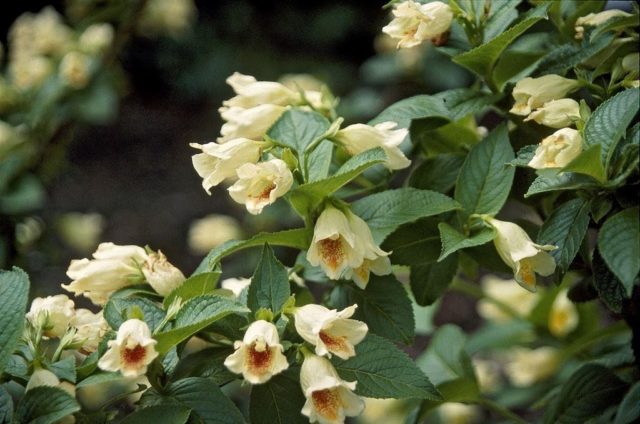

- Weigela japonica is a plant no higher than 1 m. Leaves up to 10 cm long, slightly pubescent. In the middle lane, a culture needs shelter, but freezing is possible even after warming.


- Weigela suavis is a variety growing in the Kuril Islands, Primorye, Sakhalin. Rarely cultivated. The flowers are pink-purple, pink inside. The height of the shrub is 1.3 m.
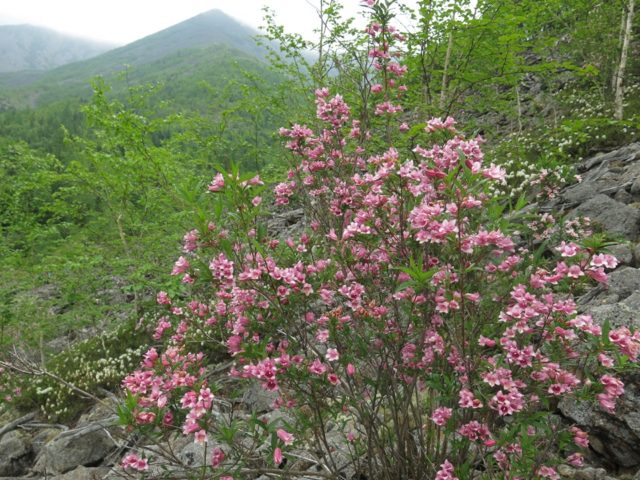

- Weigela praecox - common in North Korea, in the south of the Ussuri region, prefers rocky slopes. Flowers are bright pink, white with a yellow tinge in the pharynx. It is recommended to plant in groups, singly on lawns, like a hedge.


- Weigela coraeensis is a Korean shrub that can grow up to 5 m.In winter, it is necessary to warm the planting, the seeds in the middle lane do not ripen. Flowers reach 3.5 cm in length, pink.


- Weigela hortensis is a Japanese plant similar to the Korean variety. It is advisable to cover young specimens, adult bushes are frost-hardy.
- Weigela maximowiczii is a shrub no higher than 1.5 m, flowers are yellow, large. Distributed in the middle lane, begins to bloom in May.
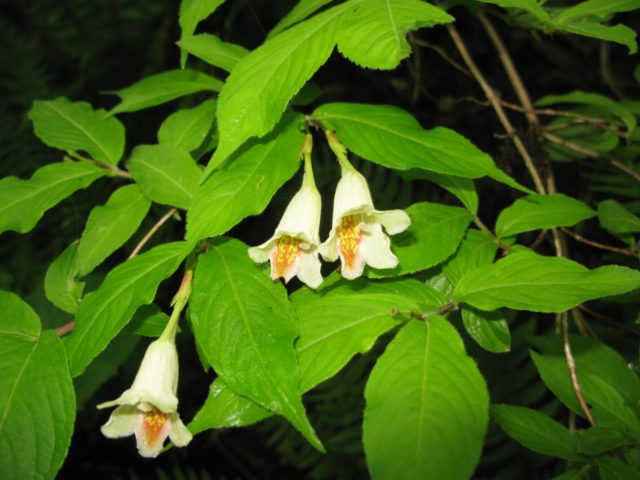

- Weigela florida - common in Europe, garden forms have colored foliage. Flowers are pink.
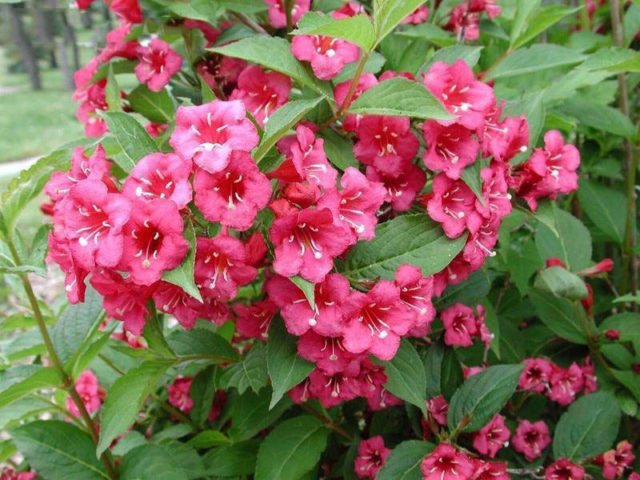

Pruning adult weigela in spring
And how to prune a weigela, which is already considered an adult plant? In this case, gardeners carry out formative pruning in the middle of summer, when the first flowering has already passed, and new shoots have not yet had time to grow. Just remember that re-flowering will occur on the shoots of the current year. Therefore, if you did not have time and the shoots began to grow, it is better to give up summer pruning altogether.
How to prune a weigela in the spring, so that the number of buds increases each time, and the growth of new shoots accelerates? In truth, it will depend on which plant you choose.
Remember also that anti-aging pruning is good for adult bushes once every three to four years: it involves the complete removal of all branches older than three years, and those that are younger - shortening by a third.
Weigela varieties with photos, names and descriptions
The photo and name of the weigela, with or without flowers, will help you choose the desired variety, or determine the existing one. Each group of varieties has its own characteristics. So, hybrids look more impressive, undersized ones can be placed in flower beds, and winter-hardy ones do not need to be covered in autumn.
Low-growing varieties of weigela
Weigela dwarf varieties do not exceed 1.5 m in height. Most often, the bushes are even lower.
Minor Black


The height of the bush of representatives of this variety weigel is not more than 0.75 m, the maximum width is 1 m. The shoots are red-brown, the leaves are shiny, medium-sized, the same color as the shoots. Inflorescences appear in June, flowers are 2.5 cm in diameter, dark pink in color.
Monet (Verweig)
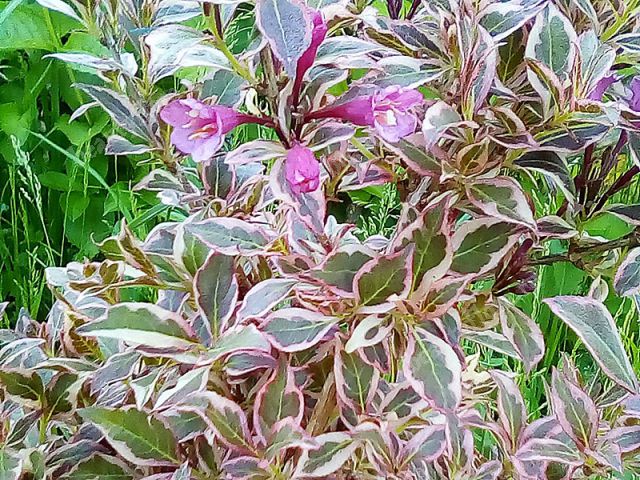

The height of the bush of this variety of weigela never exceeds 0.5 m. The leaves give the plant a special decorative effect. The leaf plate is colored in various shades - from green to red-pink. In summer, a white-pink border appears. In autumn, the border darkens. It blooms with light pink flowers.
Nana purpurea


The shrub never grows above 1 m. Weigela leaves are dark red, medium-sized. Flowering begins in June. Inflorescences of various pink shades are striking against the background of red foliage. It is recommended to plant the variety singly (as an accent color).
Victoria
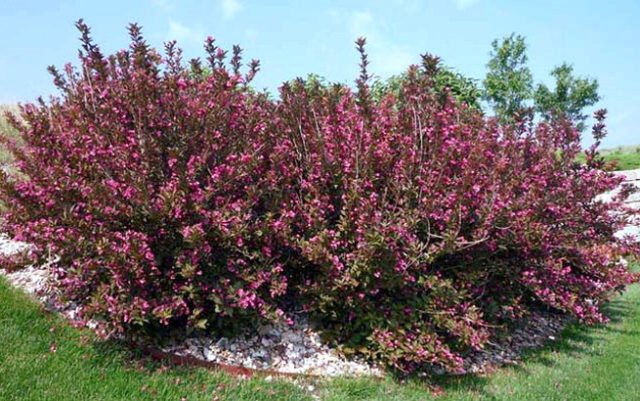

In all respects, this weigela is similar to Nana Purpurea - no more than a meter, dark red crown, compact. The leaves are medium-sized, the inflorescences are pink, of various shades. The size of the flowers is proportional to the growth of the bush - no more than 2–2.5 cm. It is permissible to plant weigels Victoria and Nana Purpurea in a group.
Frost-resistant varieties of weigela
Winter-hardy varieties of weigela do not require shelter during an ordinary winter. Extremely cold, little snow is also tolerated well, however, additional insulation may be required.
Alexandra
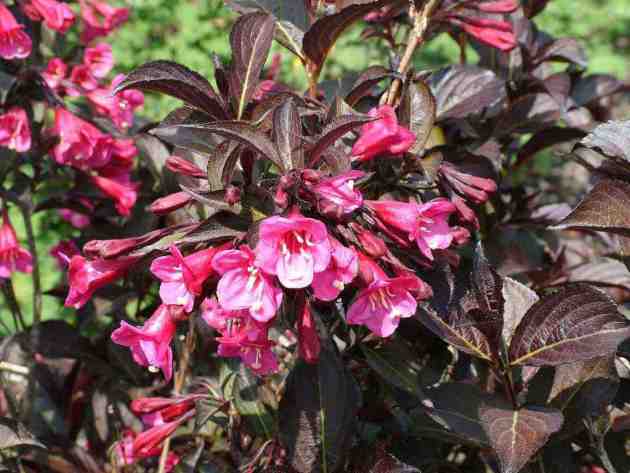

Shrub 1.5 m high, has a spreading, wide crown. The foliage is either greenish-bronze or red-green. Blooms profusely, inflorescences are dark pink. Alternative name for weigela "Wine and Roses" (wine and roses).
Brigela
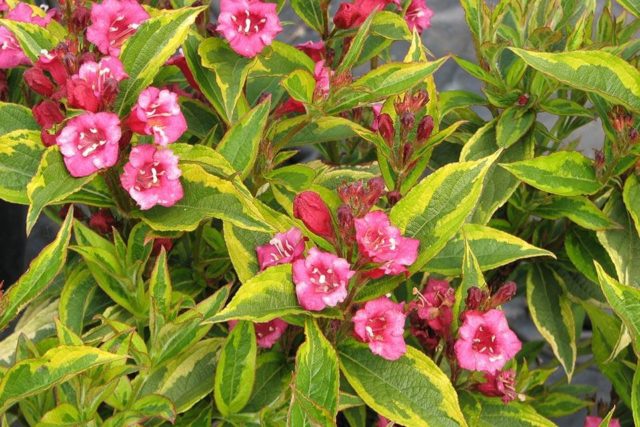

Tall, fast-growing weigela. The maximum height of the bush is 2.3 meters. The leaves are colored green and have a yellow border. The flowers are dark pink, bell-shaped. Due to its height, it is advised to plant this variety singly or in a group.
Purpurea
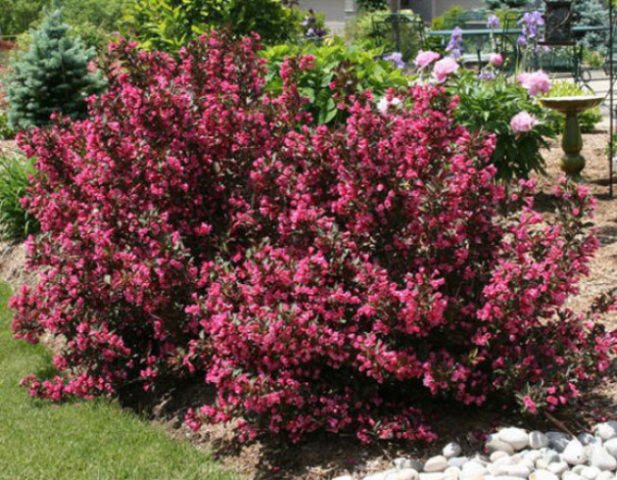

The plant is up to 1.5 m tall, the crown is dense, spreading, up to 2 m wide. The foliage changes color depending on the season. In spring, the leaves are red-brown, dark, then change color to a brown-green (red-green) shade. Flowers stand out strongly - bell-shaped, dark pink outside, light inside.
Rumba
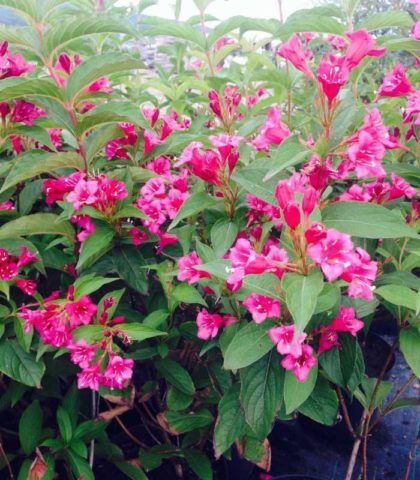

A relatively undersized winter-hardy variety, not higher than 1.3 m. The crown is dense, compact. This variety of weigela belongs to varieties with dark leaves. Abundant flowering, tubular flowers, deep pink color. This variety is frost-resistant.
Hybrid weigela varieties
Varieties of hybrid weigela (below in the photo) are of different frost resistance, the description must include an indication of how well the bush will endure the winter.
Bristol ruby


The largest among the hybrid varieties, up to 2.8 m in height, spreading crown, up to 3.5 m in diameter. The shrub is fast-growing. The bright green leaves are large, sometimes glossy and shiny. Flowering occurs in June, ruby red inflorescences. In winter, the ends of the branches often freeze slightly, but the plant quickly recovers.
Candida
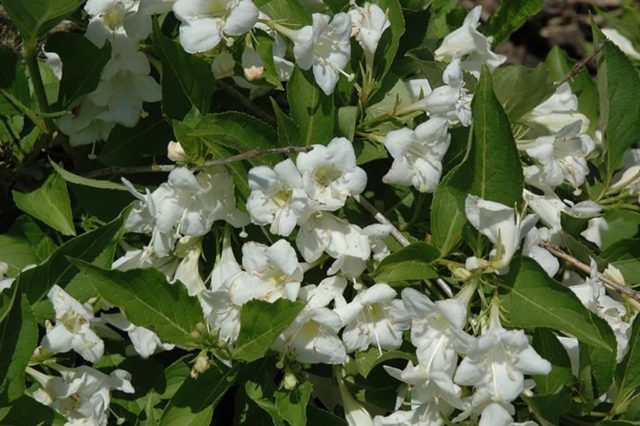

Tall shrub (2 m) with a compact crown, no wider than 1.2 m. The foliage is light green in color. Flowering begins at the end of May, the flowers are bell-shaped, large, snow-white. The color of leaves, flowers, remains unchanged. Weigela Candida belongs to frost-resistant varieties that can overwinter in central Russia without shelter.
Eva Rathke
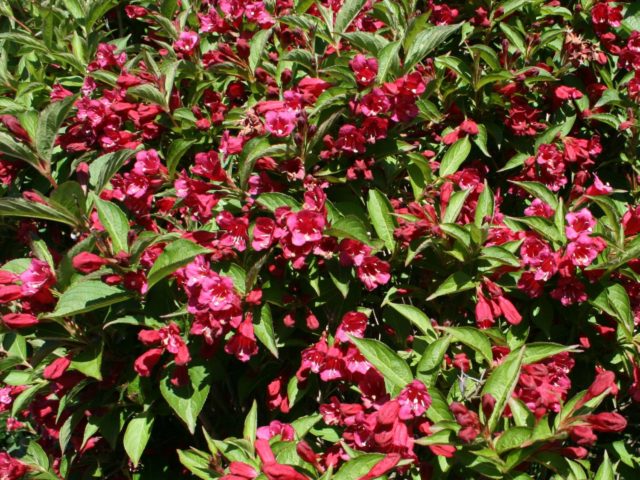

A low-growing (up to 1 m) bush with a wide, spreading crown. The growth rate is average. Bright green foliage contrasting colors - carmine red on the outside, light pink on the inside. The flower is tubular. Long bloom, from June to mid-August. The variety has an average winter hardiness.
Naomi campbell
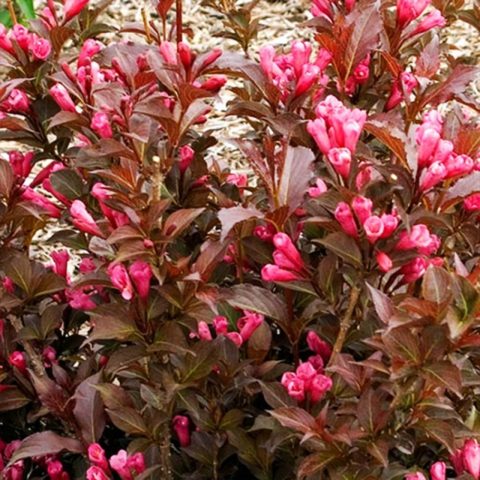

The bush belongs to dwarf hybrids of weigela, the height is not more than 0.6 m. The crown is compact, equal to the height of the plant. The leaves are dark purple, bronze. Purple-red flowers appear at the end of May. The variety is winter-hardy. This hybrid can be planted in flower beds, borders, flower beds.
Combination with other plants
Weigela combines wonderfully with other plants. A flowering shrub hedge will perfectly set off the monotony of conifers. In a group composition with juniper, cypress, boxwood or berry yew, weigela will become a bright highlight of the mixborder, making it more picturesque. The neighborhood of weigela with a cotoneaster, barberry, rhododendron looks good. Medium-sized varieties are beautifully complemented by fern bushes. Low-growing representatives of weigela look great in a company with hosta, irises, petunias or hyacinths.
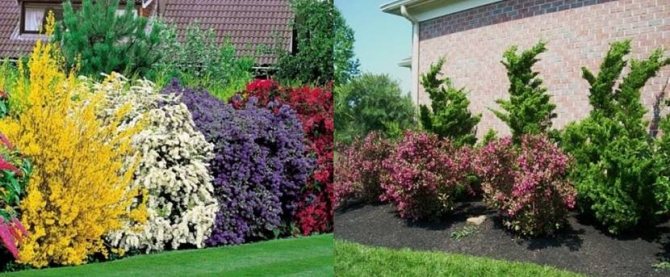

Combination of weigela with pines, cypress trees, other ornamental bushes
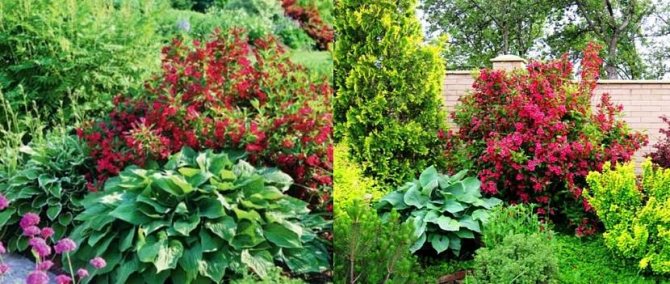

Weigela in mixborders with juniper, thuja, boxwood, hosta
How to choose the right variety
The choice of flowering weigela or another variety should be made not according to the photo, but according to the description and individual characteristics of the planting site.
- For the middle lane, northern regions, frost-resistant varieties are recommended. Heat-loving species do not survive the winter even when sheltered.
- For alpine slides, flower beds, borders, it is better to choose the lowest-growing varieties. The exception is complex multi-tiered compositions. In that case, a medium-sized shrub with a not very spreading crown is planted.
- In dry climates, it is advisable to choose a shrub where watering is possible. Large specimens will require abundant, regular irrigation, especially varieties designed for the weather in the middle zone.
- When you plan to plant a weigela under the windows, in a small front garden, you should choose a variety that does not grow above the windowsill. They also take into account the photophilousness of the variety, because some do not tolerate shade.
Growing tips
Recommendations for agricultural technology weigela:
- Weigela prefers a warm climate, and despite the fact that there are quite frost-resistant plant species, it is hard to endure the winter, and requires shelter.
- The site for planting should be chosen sunny, with loose fertilized soil.
- Planting is done in spring.
- Further watering of the bush should be regular and abundant.
- It is useful to carry out mulching and loosening of the soil, as well as formative pruning of branches.
All types and varieties of weigela are very popular in landscape design. The spreading crown of weigela looks especially impressive in a garden decorated in Japanese style. Considering a photo of this wonderful bush, you certainly want to have one on your site.
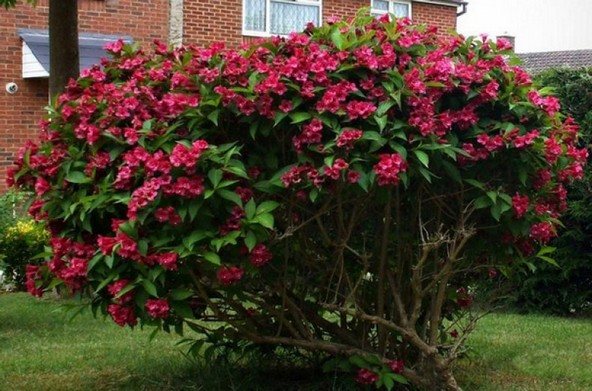

Weigela
The Weigela genus is represented by 15 species growing in East Asia.
Weigela is a very beautifully flowering deciduous shrub, prone to re-flowering, with large flowers about 5 cm, having a tubular bell-shaped or funnel-shaped, two-lipped corolla, cream, white and different shades of pink or red color, changing during flowering.
Weigela flowers are solitary, but, as a rule, are most often collected in inflorescences, located at the tops of short shoots.
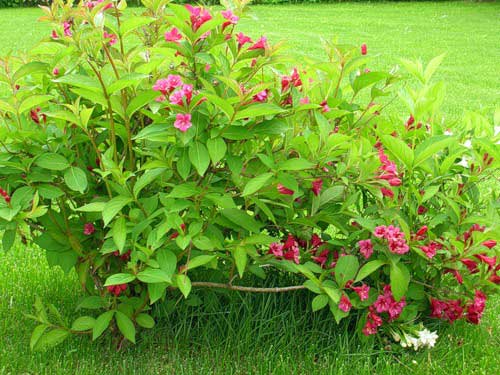

The great decorativeness of the weigela, the ease of reproduction and care, have long been of interest to flower growers who know about 5-7 species and 10 varieties.
Weigela is photophilous, achieves good development in open, illuminated places. Some species can tolerate slight shading. Flowers and its leaves are easily damaged by the wind, so it should be planted in sheltered places. Weigela weakly blooms in the shade.
Weigels can be planted with other shrubs, for example, low barberries, cotoneaster, Argut and Vangutta spireas, Buldenezh viburnum, Japanese quince, as well as among conifers - cypress, juniper. Single specimens of weigela are very effective.
Flowers
Weigela ornamental shrub delights connoisseurs of true beauty. The flowers of this plant look great against the background of emerald lawns.
Variegated or bright green leaves accentuate the pleasing appearance of the weigela flowers. Tubular buds up to 5 cm in size are often collected in inflorescences. There are varieties with single flowers.
Breeders brought many hybrid varieties with buds of various shades... There is even an original Carnival variety: on one bush there are flowers of different tones.
The color of the buds may change during the flowering season. Weigela blooms twice a year:
- first time in May;
- the second period is in August - September.
Types and varieties of weigela
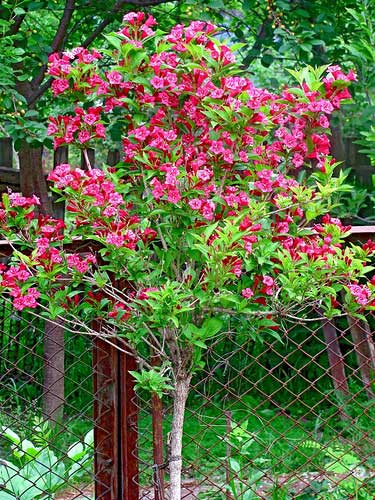

Weigela blooming
Grows in Japan, Primorye and North China.
Shrub 3 m tall. Young shoots of weigela blooming with two rows of hairs. Annual shoots are red-brown, then gray. Leaves are short-petiolate, elliptical, pointed at the apex, serrate, glabrous above, tomentose-pubescent below or pubescent along the veins. Flowers in 4-flowered inflorescences on short lateral shoots, abundant, bright pink. It begins to bloom in May at the beginning of June. Bloom for about 20 days.
Weigela blooming can grow in the sun, in partial shade, but in forms the foliage in partial shade turns green. In the conditions of the Moscow region, it is not winter-hardy. However, flowering weigela quickly restores its crown, turning into a compact bush, which manages to bloom most often in the second half of summer. Loves moist, fertile and slightly acidic soils. Does not tolerate stagnant water. Growing rapidly. In severe drought, it needs watering. Colorful during flowering. It is used in group, single and border plantings.
Garden forms of weigela blooming:
Weigela blooming 'Purpurea' ('Purpurea') - shrub 1.5 m in height. The leaves are brown-red, elliptical, 8 cm long. The flowers of the 'Purpurea' weigela are dark pink with a yellowish center.


It blooms in June. It grows rather slowly. Weigela 'Purpurea' overwinters with a shelter.
Weigela blooming ‘Variegata’ (‘Variegata’) - frost-resistant form with small leaves. The length of the leaf is about 5 cm. The height of the bush is about 2.5 m.
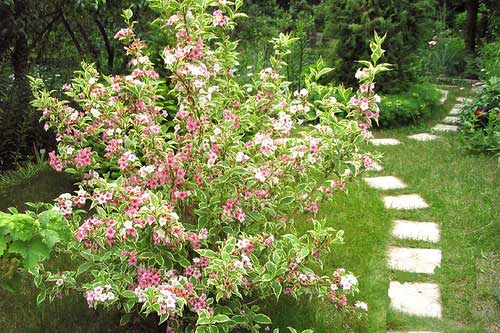

Flowers 3 cm in diameter, pink, clustered in racemes, with small leaves at the base.
Weigela blooming 'Nana Variegata' - low shrub 1 m tall, on leaves with a yellow border. Weigela flowers 'Nana Variegata' are medium in size, 2.5 cm long, crimson or white-pink, collected in 4 pieces. Weigela 'Nana Variegata' grows slowly.
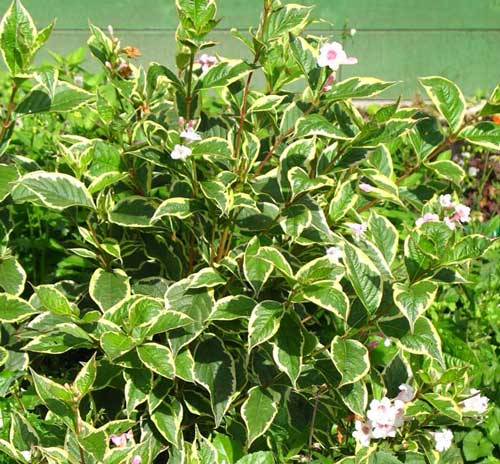

Recommended for rocky gardens.
Weigela hybrid
Weigela hybrid has an elegant spreading crown, and also lush flowering. The bush is 1.5 m tall. It is very beautiful during the flowering period. The flowers of weigela hybrid are tubular-funnel-shaped, collected in a loose inflorescence. They bloom on young leafy shoots.
They are purple, pink, pinkish-violet, white and violet-carmine of different shades, they have a wonderful aroma.
Under this name, several hybrid forms are combined, differing in the colors of flowers and leaves. They were obtained by crossing between weigel species: garden, flowering, Korean and profusely flowering. In culture, hybrid forms of weigel are used more often than wild species.
The following varieties of weigela are popular among fans in Russia:
Weigela 'Bristol Ruby' - shrub 3 m tall. Weigela 'Bristol Ruby' leaves are bright green, 10 cm long.
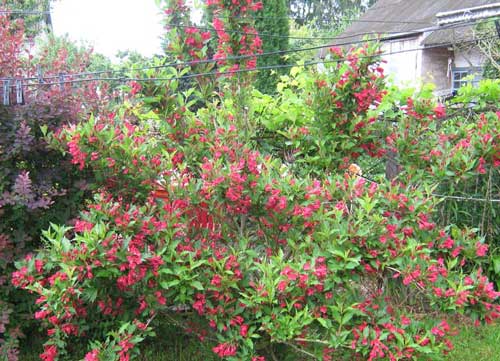

At the edges, the flowers are ruby-red, sometimes with an orange-reddish center. Weigela 'Bristol Ruby' blooms in June, growing rapidly.
Weigela ‘Eva Rathke’ - is a hybrid between Korean weigela and abundant flowering weigela. Low compact, 1 m tall bush. Weigela 'Eva Rathke' leaves are elliptical, bright green, pointed, 10 cm long.
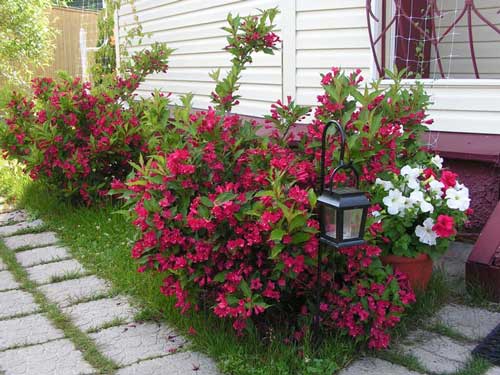

The flowers are tubular, red-carmine, shiny, lighter inside. Weigela 'Eva Ratke' blooms in June, grows moderately quickly.
Weigela ‘Rosea’ - bush 1.5 m high, with a spreading crown. Weigela 'Rosea' has very large flowers with a spike-shaped limb, pink, slightly dappled with white.


In autumn, the leaves are variegated red. Weigela ‘Rosea’ winters better than all of the above, she needs a little leaf cover.
Weigel Middendorf
It grows in the undergrowth of deciduous and coniferous forests, in the Primorsky Territory in the thickets of cedar, on Sakhalin, in Japan, in northeastern China.
Weigela Middendorf grows singly, in groups, forming thickets on gentle, humid slopes, in the upper reaches of springs, along rivers and streams, along stony placers, in the subalpine belt along glades and forest edges.
Weigel Middendorf - deciduous shrub, 1.5 m in height.
The leaves are pointed, ovate or oblong-elongated. Weigela Middendorf flowers are large, bell-funnel-shaped, yellow, with orange dots in the pharynx, in small-flowered inflorescences. It blooms twice a year, in spring and autumn.


Due to the ability of Middendorf's weigela to bloom again, from August to the end of September, the seeds ripen in 2 periods: in September and in October.
The autumn color of the Middendorf weigela leaves appears in early October. Leaf fall in the middle lane is extended throughout October. Weigela Middendorf is one of the most promising shrubs for landscaping thanks to its graceful growth, original flowers and a proportional crown.
Weigela Middendorf is recommended for both group and single landings.
Weigela early
Grows in single plantings or in small groups on the edges of the south of the Ussuri region and rocky slopes, in China, North Korea.
Weigela early is a spreading, densely leafy shrub up to 2 m tall. Its bark is gray, light brown on the branches, its young shoots are reddish.
The leaves of this species are elliptical or oblong-ovate, shortly pointed or sharp, serrate-toothed along the edge and pubescent on both sides.
In spring, as well as in summer, the leaves are bright green, in autumn they are brown-yellow. Early weigela flowers, 3 on drooping peduncles, pubescent, bright pink; blooms for 30 days. Early autumn color of weigela leaves is noticeable at the end of September.
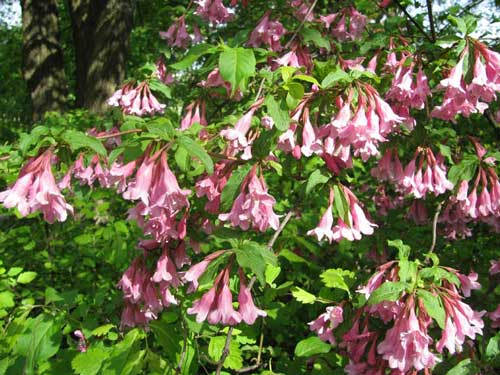

In central Russia, weigela early became the most decorative representative of this genus, thanks to its abundant, long-lasting flowering, light purple-red flowers. In winter, it can freeze slightly, needs shelter.
The early weigela is undemanding to soils, easily tolerates transplantation. It develops best in sunny places. Planted singly. Weigela early is very beautiful in live uncut hedges.
How to properly prune a young weigela in spring
Of course, like any other bush, this plant must be trimmed. Sanitary pruning of weigela in the spring is prescribed for young shrubs: the procedure involves the removal of diseased, broken, frozen and thickening branches.
The main pruning of weigela is carried out for decorative purposes in the summer. They can perform this procedure in the spring, but only for prevention.
To understand how to trim the weigela, wait until the buds begin to swell. Only then will you be able to assess the scope of the upcoming work.
And now we offer you step-by-step instructions on how to cut the weigela correctly:
- First, you should carefully examine the branches of the bush.
- Then you need to find weak or frozen shoots.
- Naturally remove them.
- Those shoots that are partially frozen, simply cut off to the most extreme healthy bud.
Do not forget about the fact that only sanitary pruning is carried out in the spring. It is necessary to give time to grow the remaining shoots until summer.
By the way, another advice that experts often give is as follows: even if a whole shoot is frozen, when pruning, leave a small part of it (no more than 6 cm), which is closer to the ground. There is a chance that a bud that is close to the soil will still wake up and become a strong shoot.
Shelter for the winter
It is not enough to know how to care for weigela - it is important to properly prepare the plant for winter frosts
Frost-resistant varieties should be covered with earth to prevent freezing of the root collar. It is advisable to throw an additional layer of snow into the trunk circle. In this case, care should be taken that the snow does not damage fragile branches.
Not all species and varieties of this shrub are winter-hardy, but with good shelter for the winter they can be saved.
- After the leaves have fallen off, each bush is covered with earth to a height of about 20 cm. Instead of earth, you can cover the base of the plant with a thick layer of leaves.
- All branches are tied into a bunch in several places. They connect not only thermophilic varieties, but also frost-resistant ones. So fewer branches will break from heavy sleet.
- You can lay the bush on the ground and make a solid frame over it. A dense covering material is stretched on it in two layers. It is important to anchor the agrofiber to the ground so that the wind does not carry it away. Any available materials are suitable - bricks, boards.
Another option for shelter is that a bush tied with twine is not laid on the ground, but wrapped in several layers of burlap or agrofibre. It is necessary to seal the shelter from above, and press the lower part to the ground.
Species diversity
It is known about 15 plant species growing in natural conditions. Cultivated and suitable for landscaping are considered to be 5:
The growth of the shrub is on average 2 meters, the crown has a spherical shape. The inflorescence consists of 2-3 flowers, drooping shape. Shades of open corollas vary from deep pink to bright red. The bud is always the same color - purple. Flowering lasts 30 days (May to June). It is planted in a mixborder and as a tapeworm, against the background of a lawn. Also used as a hedge gardening plant.
Rare view. Natural habitat - Kuril Islands, Sakhalin, Primorye. Height reaches 120 cm. Leaves are green, oblong. The shade of the leaves is pink-purple, the flower has the shape of a funnel, the diameter of the corolla is 3 cm. Flowering lasts 3 weeks (late spring - early summer). Re-flowering sometimes occurs (late summer - early autumn).
A very bright and unusual bush. The greens of the leaves have a bright and juicy hue. It is used for hedges. It blooms very quickly. It reaches a height of 2-2.5 meters. The inflorescences have the shape of a bell of a bright red hue. Re-pruning the crop can provoke flowering a second time.
Originally from the land of the rising sun. Flowers are bright red. Color twice, almost continuously. Between the first and the second period there is an interval of 2-3 days. The shrub is low - 90-100 cm, 160-180 cm wide. The buds are decorated not only with young, but also with old shoots. Gardeners use this variety for planting in flowerpots, pots and pots.
The culture is created to grow in the garden. The bush reaches 1-1.5 meters. The leaves are bright green, with a lowered shape. Flowers are gray-yellow with orange splashes. It blooms twice: in spring (in May) and in late summer (in August). Duration 20 days. In landscaping, it is used as a lawn decoration, planted under tall trees with an openwork crown.
Landscape design
The most popular role for shrubs is hedges. It can replace the boring low fence that separates your backyard from the neighbor's. Regularly trimming the branches will create a beautiful, even border.
In combination with conifers, weigela forms graceful compositions. Group plantings with shrubs look elegant, solemn and attractive.
Weigela is an amazingly beautiful shrub that will give the area around the house a special charm. This is a bright touch to your garden. Take care of the plant according to the advice of our article, and it will thank you with lush flowering.
Growing seedlings from seeds
Weigela is successfully bred on the site, if the seeds are collected in the fall, they are sown in containers for germination.Before sowing, the seeds are soaked in a growth stimulator (Kornevin gives a good result), the duration of the procedure is from two to three hours.
Next steps:
- take a box with drainage;
- pour a universal substrate;
- moisten the soil;
- sow seeds on the surface of the soil, be sure to sprinkle with fine-grained, sifted sand (layer - about 5-6 mm);
- covered with a film, then placed in a warm place: indicators at the level of + 22 ... + 25 ° С;
- periodically water, ventilate, remove condensate from the lid, check seedlings for germination;
- after seed germination, the shelter is removed;
- put on a well-lit windowsill;
- after 14–20 days, the most beautiful, strong sprouts are chosen,
- picking seedlings into separate pots: be sure to make drainage holes in the bottom;
- after two weeks, Kornevin fertilizer is applied to develop a strong underground part.
When weigela is grown from seeds, the first flowering of the bush occurs no earlier than 4-5 years.
Soil and capacity
One of the main factors for good plant growth is the selection of a suitable soil.
The substrate must meet the following conditions:
- have a certain acidity: indicators are normal - from 5.5 to 7.0, suitable for chemical composition;
- not be out of date;
- it is useful to choose soil from well-known manufacturers, with a quality certificate check.
For the first planting of seeds, use a large container or container. Subsequently, the seedlings are transplanted into separate containers: pots, peat glasses, flowerpots with drainage holes.
Seedling care
Procedure:
- put seedlings in a zone of good lighting;
- room temperature should be + 22 ° С, air humidity 50–70%;
- timely watering using settled liquid is important. It is important that all the substrate is dry;
- after 21 days, transplant the plant into separate pots;
- the first feeding is carried out with phosphorus-containing fertilizers for root development a couple of weeks after the pick;
- in the future, they monitor young bushes so that diseases and pests do not appear;
- protect from drafts.
On a note! With a lack of light, you can illuminate the weigela seedlings with lamps. With insufficient humidity in the room, air humidifiers are used, foliage is sprayed from spray guns, trays with water are placed next to the plants. Nitrogen minerals are also added for better growth and development of green mass. 2 weeks before planting the weigels on the site, they begin to harden the flower: take it out to the balcony, loggia with a gradual increase in the procedure time.
Transplanting
In the spring, weigels are transplanted in garden and summer cottages. The optimal time is from March 25 to April 10. It is not recommended to plant seedlings in the fall: a young, not strong plant may not survive the frosty winter.
The main requirements for growing weigela outdoors:
- choose a sunny or poorly shaded place, protected from the wind;
- dig holes 50x50 cm, with a distance of 2–2.5 m from each other;
- a drainage is placed on the bottom: a layer of about 15 cm is enough;
- fill with a fertile substrate: a mixture of deciduous, sod land, humus, sand. The first two components - 2 parts each, the second - 1 part each;
- add 10 g of nitrogen and the same amount of phosphorus-potassium mineral fertilizers;
- bushes are transplanted so that the root collar is above the ground;
- watered abundantly with water: enough 5-10 liters per plant.
Top dressing and fertilization
If, when planting the bushes, you added nitrophosphate and compost to the soil, fertilization can be omitted for the next two years. In the third year, stimulate the growth of leaves and shoots. To do this, in the spring, when the snow has not yet completely melted, it is advisable to apply fertilizer under the bushes:
- urea - 20 g / m2;
- superphosphate - 10 g / m2;
- potassium salt - 10 g / m2
Can be fertilized with Ammophos, Diammofos, Kemira-Lux or other fertilizing with phosphorus, potassium and nitrogen.
The second top dressing will be useful when decorating the buds in late spring. Superphosphate (30 g for each bush) is suitable. After that, the weigela will bloom luxuriantly, and the branches will strengthen for the winter.
Before digging in autumn, apply a third top dressing with wood ash (200 g per square meter). "Kemira - Autumn" works well, the dosage is indicated in the instructions.
Attention! After each feeding, water the bush abundantly and spray with soapy water and alcohol.
Answers on questions
How long does a shrub live?
If you manage to create favorable conditions and organize good care, the shrub can live up to 50 years.
Why does not weigela bloom?
The plant may not bloom in the shade, due to a lack of illumination, the shoots become woody, and flowering becomes very scarce or completely absent. Another reason is insufficient watering and lack of feeding. If these obstacles are excluded, pay attention to the root system, it may be damaged by pests.
Reproduction
Seeds
When weigela is propagated by seeds, their germination lasts about a year. Lovers breed weigela at home in flower pots under glass or foil. A one-year-old weigela seedling has a length of 6 cm, a two-year-old 0.5 m. After the appearance of true leaves, the seedlings dive. Weigela needs to be grown in the summer at their summer cottage.


The plant has a fibrous root system and spreads rapidly underground. Varieties are best propagated vegetatively. Cuttings are carried out in the first half of summer before flowering.
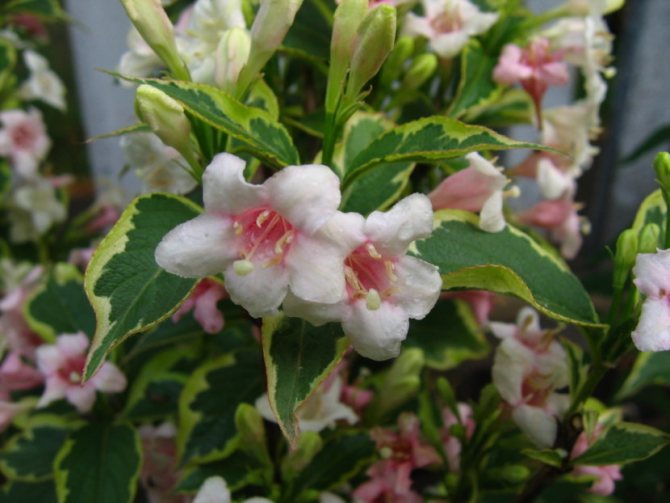

Cuttings
Weigela, propagated by cuttings in summer, blooms after 2 years of age. How is grafting carried out?
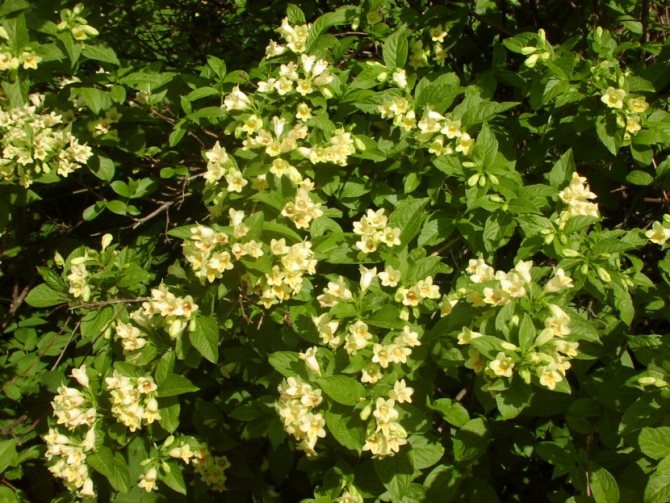

Slightly lignified young shoots are used for cuttings. They should consist of one internode and several leaves.
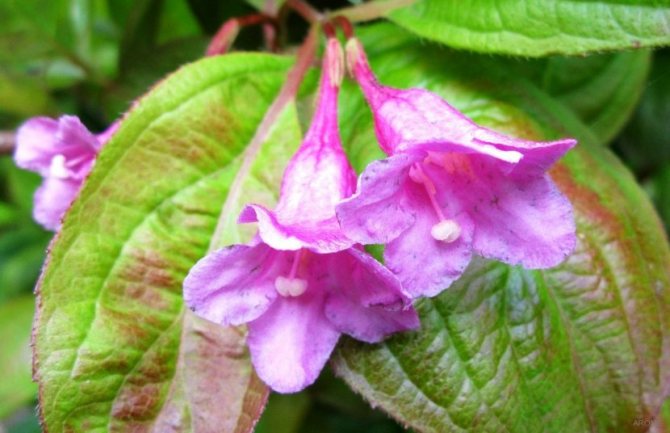

Summer cuttings
- Step 1: Weigela leaves are removed in half or completely.
- Step 2. The cuttings are placed in water for several hours, dipped in the root, and kept for half a day in a dark room.
- Step 3. Planting of plant cuttings is carried out in the second half of June. The soil should include sand and peat. The weigela stalk should be in the ground at a depth of about 1 cm. The young stalk is covered and watered several times a day.
Winter cuttings
Cuttings, 20 cm long, are also cut in April before the leaves open.
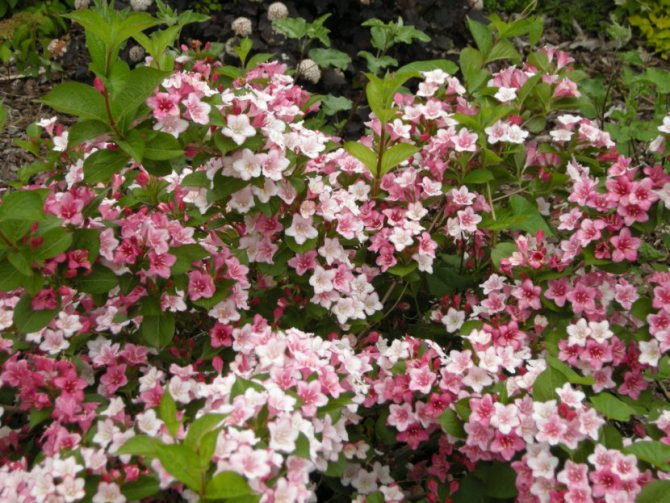

- Step 1. Peat and sand are poured into the pots in a 1: 1 ratio. The planting material is treated with root roots.
- Step 2. After a month, pinching is done, and top dressing is applied.
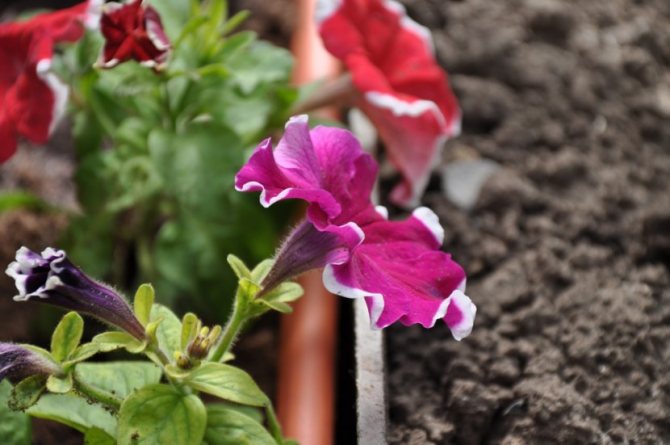

Landing
Weigela is planted in the ground in the spring. The earth should warm up, but the kidneys are not yet swelling at this time. After planting in autumn, shrubs often die in the first winter. Find an elevated, well-lit area on the south side of the house. Please note that in a draft, the shrub is unlikely to bloom or crumble even at the bud stage.
Weigels love loose and rich soil with humus - loamy or sandy loam with a neutral or slightly alkaline reaction. Of all the types of shrubs, only weigela Middendorf grows on peaty soil. Seedlings older than three years are suitable for planting.
Weigela planting methods
Weigela needs a loose and permeable soil. Excessive moisture is contraindicated for a shrub, do not plant bushes in areas where water stagnates for a long time after floods or groundwater is too high. Lime the sour soil before planting the bush (in the fall).
Advice. Many seedlings do not take root during autumn planting, so postpone the procedure until early spring, digging in the seedlings at an angle and covering most of the crown with soil.
When preparing a pit for planting, the quality of the soil is taken into account. In rich soil, a deepening of 30-40 cm is enough, if the soil is poor, the depth should be increased. Create improved conditions for the plant by placing on the bottom:
- drainage (15 cm of broken brick, sand or gravel),
- a layer of fertile soil fertilized with nitrophos (100 g for 1.5 buckets of compost).
The bush will take root more easily if the roots are treated with a rooting stimulant.
For large varieties of weigela, free space is needed so that they can develop normally. When planting several bushes, place them at a distance of at least one and a half meters. For medium-sized varieties, a gap of 70-80 centimeters will be quite sufficient.
Gently spread the roots of the seedling and make sure that no voids form when you fill in the soil.
Attention! Do not deepen the root collar more than 2 centimeters so that after the soil subsides, it will be flush with the surface.
When the seedlings are placed in the ground, water and mulch the area abundantly. Seedlings should be watered abundantly for another 3-4 days. If the summer is dry, water the young bushes regularly; next year, watering may be more moderate.
Possible growing problems
Weigela is an unpretentious plant and does not cause much trouble when growing. Sometimes it happens that a planted plant develops normally, but does not bloom in due time. It is difficult to say what is the reason, but often, after transplantation, the shrub comes to life and pleases the owners with bright flowering. Perhaps the location was poorly chosen, or the composition of the soil did not suit the plant.
Of the pests, aphids, spider mites or caterpillars can attack the weigela. At the first signs of insects, it is necessary to treat the shrub with an insecticide. Today on sale you can find a huge amount of pesticides for all occasions. However, it is worth giving preference to biological drugs such as Fitoverm, Akarin, Iskra-Bio - they bring no less benefits than their poisonous counterparts, however, they do not harm the environment. It is only important not to spray the plants with these preparations during flowering, so that the bees do not suffer.
The main diseases of the shrub


Sick Weigela Leaves
The main pests that destroy the leaves and flowers of the bush are aphids and leaf-eating insects. Spider mites and thrips are no less dangerous. Having found insects, they must be carefully removed and the plant treated with special solutions to prevent re-infection.
For the root system of the bush, the larvae of various insects are dangerous, for example, the bear or the May beetle. These pests will have to be dealt with with the help of chemicals that significantly spoil the condition of the soil and shrubs in general. Spraying a soap solution over the weigela with the addition of wormwood, onions, garlic or pepper will protect against flying insects.
Rust and mottling and gray rot are more common diseases. It is better to prevent plant diseases with the help of regular treatments with solutions of copper sulfate. It is better to cut off damaged areas and burn them away from other cultivated plants so that the disease does not spread to them.
Variety of choices
The genus was discovered by Professor K. Weigel. Now 15 species of perennial, beautifully growing shrub with green leaf fall have become famous. It is able to bloom 2 times a year, delighting with amazing inflorescences around May and September.
The original buds (2-5 cm) range in color from pale cream to almost white to dark purple. Breeders have developed hybrid varieties capable of having buds of different tones of pink on one bush ("Carnival"). We also worked on the height - now there are specimens from dwarf to high (over 3 meters). When choosing a favorite variety, and there are more than 100 of them, pay attention to its resistance to frost.
The most popular variety among the flowering Weigela is "Variegata". A rather stunted view (90-150 cm), simply strewn with bright pink tubular-bell-shaped small inflorescences, will delight you with interesting foliage.
But gardeners and landscape designers give preference to hybrid varieties.


- Middendorf. A variety of medium height blooms for up to a month, delighting with light yellow bells in inflorescences of several pieces.
- Bristol Ruby. Large-scale, well-growing representative, up to 3 m high.
- Gustav Mallet. Tall hybrid with unusually large flowers of a special shade of carmine pink.
- Weigela Early with dark pink flowers against a background of dark green leaves. Especially good for creating hedges.


Among these bushes it is easy to find your own variety, or even several.
Growing conditions, features of care and reproduction
Weigela is a shrub with some peculiarities of conditions for growth, care and reproduction. So, the plant loves the sun, but feels great in partial shade, and some species are adapted to shading. Prefers a loose fertile neutral substrate, although it tolerates slight acidification or alkalization of the soil.
The shrub likes frequent watering, but does not tolerate stagnant moisture, which necessitates drainage of the substrate. Dislikes low temperatures and winds. It is recommended to cover some species for the winter, but frost-resistant varieties have also been bred. Responsive to mineral fertilizing. Tolerates pruning well. Resistant to pests.
Propagated by seeds, cuttings, layering, but it is much easier to purchase one-two-year seedlings ready for planting in spring. This will help you quickly see the beauty of the flowering shrub and decorate the space of the site.


Shrub cuttings
By choosing the right variety of weigela, placing the main accents in the design of the site and deciding on the company of plants in the mixborder, with proper care, you can create the graceful beauty of the backyard area. The use of weigela bush allows you to show individuality, creativity, the ability to improvise.
Autumn care, seed collection and wintering
After the second flowering, charcoal is added to the soil. Other fertilizers are not recommended.
During this period, seed pods with grains ripen, which should be collected by sprinkling the seeds on a cloth and dried. Then the planting material is placed in a paper envelope, the name of the plant and the time of collection are written. Placed in a dry, dark place for storage.
Preparing for cold weather:
- The shrub belongs to frost-resistant plants, some species can withstand up to -15 ° C, but some varieties are more susceptible to frost.
- Gardeners recommend insulating the flower for the winter: they tie a special protective cloth around the bush, sprinkle the root zone with foliage on top, cover it with spruce branches.
Soil preparation
For this plant, loamy or clayey soil, neutral or slightly alkaline, is suitable. As for the Middendorf weigela, it can be planted in peaty soil (slightly acidic). Next, we do following:
- we loosen the soil;
- fertilize (preferably with special fertilizers sold in flower shops);
- add turf and sand (the first is for any soil, the second is for clayey areas);
- add crushed chalk if the soil in the area is acidic.
What to do after flowering?
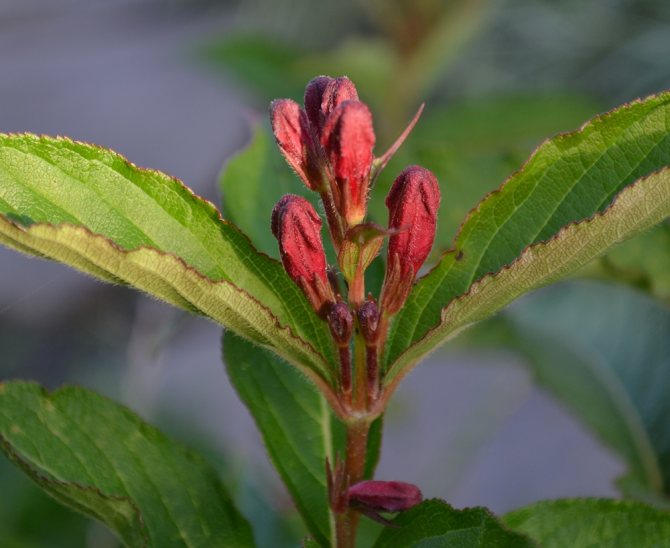

After flowering, the plant produces seed pods. This happens in September - October. To collect the seeds, you need to wrap the boxes in advance with a small layer of gauze and fix it on the bush. When the box opens, the gauze is removed and brought into the house.
There, the seeds are poured onto a newspaper and dried well with natural ventilation. After that, they can be poured into a paper bag, not forgetting to mention from which plant they were taken and mentioning the date of collection. The seeds retain their properties only for the first two years after harvest.
Seeds can be planted directly into open ground next spring and expect the first shoots. After the expiration of the shelf life of the seed mixture, you can throw out the planting material, since you can not wait for seedlings from it.
Features of agricultural technology
The soil is improved by adding sand and humus. Weigela will not appreciate excessive waterlogging: they must use drainage when planting. It is better to carry it out in the spring:
- Prepare a pit 50 * 50 cm with a drainage layer of 15-20 cm, sprinkled with earth.
- Treat the roots with biostimulants.
- Place it at such a distance that the place where the roots pass into the stem (neck) is at the level of the soil after compaction of the earth.
- Compact the soil and water.
- It is advisable to create a layer of mulch on the surface, decorative material looks especially well-groomed.
Fertilization should not be neglected, especially for young plants, but only after they have taken root. Complex mineral fertilizers are used. In autumn, it is better to use potassium-phosphorus.
Reproduction is carried out by cuttings, because the seed method is not reliable in terms of obtaining a shrub with pronounced varietal properties. The stalk is cut in June after the end of the first flowering. After being treated with a stimulant (phyton or other rooting fungicide), it is placed in a flowerpot. Within 1.5 months, a full-fledged root system will form. But a young shoot will bloom after planting in the ground only after 2-3 years.




